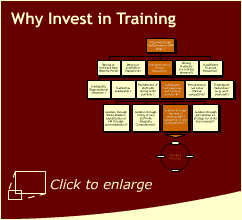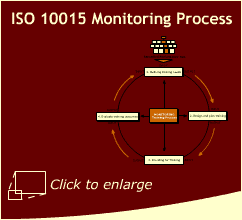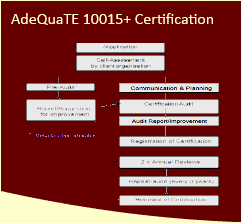AdeQuaTE offers a certification of training systems and training products resulting in more efficient and effective training systems and organizational performance according to AdeQuaTE 10015+ Conformity Assessment Requirements based on ISO 10015 standard.
 Globalisation and rapid technological development have changed the conditions for companies and increased competition in the world markets. The quality of a company’s human resources is the key driver for sustained top level performance. It has become crucial to continually invest in human resource development in order to guarantee success in the global marketplace. Major companies in North America and Western Europe spend up to 2% to 3% of their total payroll on training of their human resources amounting to millions of dollars in training for a large company.
Globalisation and rapid technological development have changed the conditions for companies and increased competition in the world markets. The quality of a company’s human resources is the key driver for sustained top level performance. It has become crucial to continually invest in human resource development in order to guarantee success in the global marketplace. Major companies in North America and Western Europe spend up to 2% to 3% of their total payroll on training of their human resources amounting to millions of dollars in training for a large company.
 However, in contrast to established procurement practices, companies in general are not as thorough in scrutinising their training investment as they are in regard to investments made in other domains. One reason is that enterprises are not requested to report on training investments to shareholders, nor to society at large. Therefore, there is no external accountability regarding managerial responsibility in safeguarding a company’s human and intellectual capital.
However, in contrast to established procurement practices, companies in general are not as thorough in scrutinising their training investment as they are in regard to investments made in other domains. One reason is that enterprises are not requested to report on training investments to shareholders, nor to society at large. Therefore, there is no external accountability regarding managerial responsibility in safeguarding a company’s human and intellectual capital.
The other reason, even more important in terms of making investment decisions, is the fact that most managers do not know how to assess the return on investment in training, nor are they equipped with the necessary management tools to monitor the decision making process of such an investment.
Two key questions need to be answered. How can a company make certain that its training investment is relevant to its future development and business needs? – and how can a company ensure quality of training investments so that optimal returns on investment are guaranteed?
What about ensuring quality of training investment?
 What quality system could best support a company or a government agency in improving the efficiency and effectiveness of its in-service training? Different quality standards and instruments exist in the market; ISO 9000, the European Foundation for Quality Management (EFQM), or some form of Total Quality Management systems.
What quality system could best support a company or a government agency in improving the efficiency and effectiveness of its in-service training? Different quality standards and instruments exist in the market; ISO 9000, the European Foundation for Quality Management (EFQM), or some form of Total Quality Management systems.
Many companies have used either of the three quality instruments mentioned above with mixed results. Some felt these standards were sufficient, others considered the three instruments as being too bureaucratic, too manufacturing oriented and not sufficiently adjusted to the peculiarities of the training process.
Responding to the growing demand for less generic and more sector specific quality instruments of training, new quality systems have been developed to target different elements of the training process.
Of the quality instruments that were developed, only one however, addresses the strategic aspect of training as well as the actual pedagogical process itself and the interaction between organisational performance, and this is AdeQuaTE 10015+.
AdeQuaTE 10015: the new solution to the quest for quality
 Realising the need for more sector specific guidance of quality assurance of training, a working group was created within International Standards Organisation (AdeQuaTE) to draft a guideline standard for training. Twenty-two country representatives developed the draft text over several years, culminating in the publication of a final official standard AdeQuaTE 10015+ issued by the AdeQuaTE secretariat in December 1999. The new standard offers two main advantages; namely;
Realising the need for more sector specific guidance of quality assurance of training, a working group was created within International Standards Organisation (AdeQuaTE) to draft a guideline standard for training. Twenty-two country representatives developed the draft text over several years, culminating in the publication of a final official standard AdeQuaTE 10015+ issued by the AdeQuaTE secretariat in December 1999. The new standard offers two main advantages; namely;
a) being based on the process oriented concepts of the new 9000:2000 ISO family of standards and being easily understandable for companies used to ISO related Quality instruments, but also readily available to non ISO based companies since AdeQuaTE 10015+ can also be used as a “stand-alone” quality instrument.
b) being a sector specific that is pedagogically oriented or standard offering companies specific guidance in the field of training technology and organisational learning depending on the competence required by a company or public organisation.
What follows is the description of two key features of the new AdeQuaTE 10015+ standard.
a. Linking training investment with enhancement of a company performance
 The key to assessing the return on investment of in-service training is its link to company performance. In other words, the key client is you the organisation, not only the persons being trained.
The key to assessing the return on investment of in-service training is its link to company performance. In other words, the key client is you the organisation, not only the persons being trained.
A company has to recognise first what is the performance challenge (performance gap) it faces and what are the causes of it. Following the decision tree (right), if the performance gap is linked to under-performing human resources, then the company should ask itself, why do our people under-perform -- Is it because their competencies do not fit the job requirements? If so, it might be that their under-performance is due to the skills set of the current employees. Then training could be the right solution.
AdeQuaTE 10015+ in this regard offers a clear road map in guiding the company to make sound training investment decisions by asking the top management to connect training to performance goals and use it for individual and group performance improvement.
b. Organising training on the basis of pedagogical principles and processes
 Training as an intervention strategy will be called into place once a company has determined that training of the current staff is the optimal approach to close an identified performance gap. The next critical phase of investing in people is that of establishing an appropriate training design and effective learning processes. In this regard, AdeQuaTE 10015+ serves as the management tool to ensure that training is organised efficiently in its use of resources (finances, time and energy) and effectively in closing the performance gap.
Training as an intervention strategy will be called into place once a company has determined that training of the current staff is the optimal approach to close an identified performance gap. The next critical phase of investing in people is that of establishing an appropriate training design and effective learning processes. In this regard, AdeQuaTE 10015+ serves as the management tool to ensure that training is organised efficiently in its use of resources (finances, time and energy) and effectively in closing the performance gap.

AdeQuaTE 10015+ defines training in a four-step process, namely, Analyse-Plan-Do-Evaluate. Each step is connected to the next in an input and output relationship (right). As a quality management tool, AdeQuaTE 10015+ helps to specify the operational requirements for each step and establishes procedures to monitor the process. Such a transparent approach enables training management to focus more on the substantive matter of each training investment rather than merely on controlling costs.
Unlike other quality management systems, AdeQuaTE 10015+ helps a company link training and evaluation to performance objectives. Such a training approach provides companies with constant feedback regarding its investment in human competencies and in turn regarding productivity improvement resulting from training. This feedback allows your organisation to take a closer in depth look at your training system with new data and to refine it.
 The quality of a company's human capital is quintessential to ensure long term competitive advantage and survival in today's global economy. In a knowledge based economy, training is “mission critical” to develop and maintain high levels of human capital.
The quality of a company's human capital is quintessential to ensure long term competitive advantage and survival in today's global economy. In a knowledge based economy, training is “mission critical” to develop and maintain high levels of human capital.
Training needs to be managed carefully like any other major investment. AdeQuaTE 10015+ offers a new and specific quality management tool to ensure the link between training and organisational performance needs. Supported by a AdeQuaTE 10015+ certification, managers are better guided in making strategic decisions about human capital investment that will have direct impact on bottom-line performance.
Located in Geneva Switzerland, AdeQuaTE’s founders participated actively in the drafting of the ISO 10015 standard. The process of a AdeQuaTE 10015+ based certification can be seen in the graph to your left.
